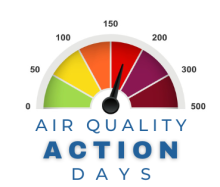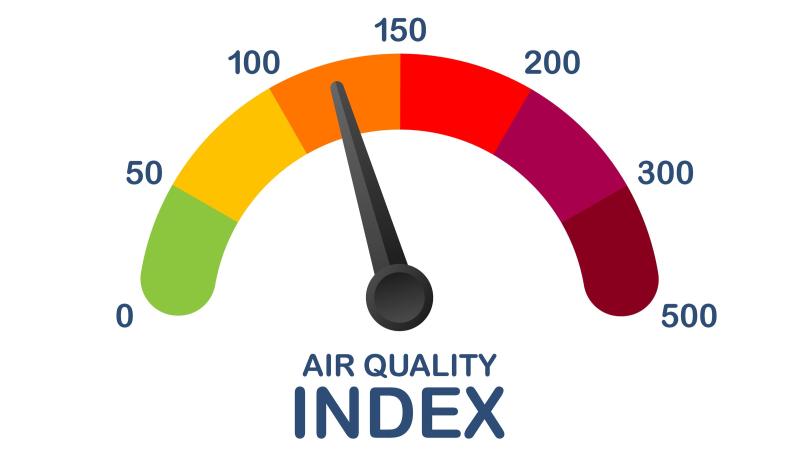Outdoor Air Quality
The City of Alexandria Transportation and Environmental Services (T&ES) Office of Environmental Quality shares information on outdoor air quality and tips on how you can help protect it.
To find indoor air quality information, please visit the City's Indoor Air Quality website.
Do Your Share For Clean Air

Summer is coming and warmer weather is here! Now is a good time to think about how our air quality can be impacted.
From May 1 through September 30, the City of Alexandria participates in the Air Quality Action Days program to remind residents about the dangers of ground-level ozone (i.e., smog) and fine particulate matter (PM2.5). Help us protect our air quality by knowing what you can do during Air Quality Action Days.
Air Quality Action Days
Air Quality Action Days is a voluntary public outreach program, sponsored by Clean Air Partners, aimed at changing individual behavior to reduce ozone and particulate matter production. As a participant, you will be notified by 4 p.m. the day before an Air Quality Code Red Day, an unhealthful air day, so that you may take action to protect your health and the environment. Individual actions will help reduce the release of volatile organic compounds (VOCs), nitrogen oxides (NOx), and particulate matter in the 2.5 micron range, especially during the hottest parts of the day. You can find many ways to protect your health and our air with the Clean Air Partners Action Guide. Both individuals and employers can sign up to receive Air Quality Action Day alerts. There's no cost to become a participant. Sign up today!
What Can I Do to Help?
Ground-level ozone levels are worse during hot weather. Watch for Air Quality Code Alerts on the City of Alexandria’s homepage or the Metropolitan Washington Council of Governments Air Quality Forecast webpage. You may also obtain real-time ozone and other air pollutant levels through AirNow.gov.
Small individual choices can go a long way toward improving regional air quality. The following are a few suggestions for actions that you may take when an Air Quality Code Red Alert, or higher, is in effect:
- Instead of driving, walk, bike, ride DASH and other bus companies in the Northern Virginia region. Visit GO Alex for additional information on using public transportation.
- Avoid excessive engine idling and do not refuel your car until evening.
- Do not mow your lawn until dark or wait for a cooler day.
- Wait until the weather cools to strip and repaint.
- Combine errands into a single trip.
- Keep your car well-tuned.
- Use walk-in instead of the drive-through line.
- Brown bag your lunch and skip the drive to the restaurant completely.
- Ride to work in a carpool or with a friend.
- Arrange with your employer to work from home.
- Click here to receive Air Quality Action Day notifications through Clean Air Partners EnviroFlash program.
What Can I Do to Stay Healthy?
Individual choices can help improve air quality and also keep you and your family safe on days when the air quality is code orange or higher. See the resources below for more information on how you can protect your health when pollutant levels are high.
- Guide to Keeping Your Lungs Happy (Clean Air Partners)
- Protecting your health when ozone pollution reaches unhealthy levels (AirNow)
- Protecting your health when particle pollution reaches unhealthy levels (AirNow)
Government Actions
The City of Alexandria participates in the Air Quality Action Days program to further demonstrate its commitment to clean air. The City is taking many actions to educate the public and City employees about the harmful effects of ground-level ozone and fine particulates. These actions include:
- Distribution of the City Manager's memo highlighting the Air Quality Action Days program.
- This section of the City's Website.
- Participation in the Metropolitan Washington Council of Governments air quality planning efforts for Northern Virginia and the Metropolitan Washington area.
State of the Air
Ozone and Particulate Matter in the City of Alexandria
The U.S. Environmental Protection Agency (EPA) first established a particulate matter standard for particles with an aerodynamic diameter of less than 2.5 microns in 1997. These "fine" particles were shown to have increased adverse health effects upon certain segments of the American public, such as children and the elderly.
In April 2019, the EPA approved Maryland and Virginia’s requests for their portions of the Washington area to be redesignated to attainment of the 2008 National Ambient Air Quality Standard (NAAQS) for ozone. On July 16, 2019, the EPA approved the redesignation of the District of Columbia from marginal nonattainment to attainment for the 2008 NAAQS for ozone.
The Metropolitan Washington Council of Governments provides a dashboard showing current and historical trends in the metropolitan Washington area's regional air quality. In an effort to address the region's air quality issues, the City of Alexandria participates in the region's air quality planning efforts for Northern Virginia and the Metropolitan Washington area through the Metropolitan Washington Air Quality Committee (MWAQC) and other committees.
Frequently Asked Questions
Q. What is the Difference Between Good Ozone and Bad Ozone?
A. Whether ozone is good or bad depends on where it is found. The ozone that is found within 10 miles of earth's surface (troposphere) is called ground-level ozone and is considered bad ozone. Ground-level ozone is considered an air pollutant and is detrimental to human health, pets, animals and vegetation. It is one of the components of urban smog. The Ozone that is found in stratosphere, between 10 to 30 miles above the earth's surface, is considered good ozone and protects us from the sun's ultraviolet rays.
Q. How is Ground Level Ozone Formed?
A. Ground-level ozone (bad ozone) is created by reaction of nitrogen oxides (NOx) with volatile organic compounds (VOCs) in the presence of sunlight. Some ozone is formed naturally from hydrocarbons and nitrogen oxides released from trees, soils, and other natural sources. Additional ozone is produced as a result of the reaction of sunlight with emissions from mobile sources (example: cars, trucks, and automobile etc.), point sources (example: power plants, boilers, and factories etc.), and area sources (example: gas stations, lawn and garden equipment, and evaporating paints etc.).
Q. Why Be Concerned About Bad or Ground Level Ozone?
A. Children and the elderly are most at risk to negative health impacts caused by ground level ozone. It can aggravate or worsen existing asthma, bronchitis, emphysema, heart disease or other respiratory diseases. Ground-level ozone can cause inflammation or damage to the lining of the lungs. Breathing ozone polluted air can cause reduced lung functions up to 20 percent even in healthy adults at higher levels. Ozone can also compromise the body's immune systems, making it more susceptible to upper respiratory diseases. Ground level ozone also has economic consequences, such as crop and forest damage, and degradation of various building materials, rubbers, and paints.
Q. What is particulate matter?
A. Particulate matter (PM10 and PM2.5) is comprised of solid particles or liquid droplets tiny enough to remain enough to remain suspended in the air. PM emissions can include everything from dust to carbon (soot) and is generated by a variety of sources such as traffic on paved road, diesel combustion, and earth moving activities related to construction and farming. The greatest threat to public health are those particles small enough (PM2.5) to be inhaled into the deepest parts of the lung.
Q. How do particles affect human health?
A. When inhaled, particles can be deposited in the airways or deep in the lungs. Once deposited, particles may be cleared by the body's natural defense mechanisms, they may accumulate on the surface where they deposit, or they may be absorbed into the underlying tissues. Extensive accumulation and deposition can cause inflammation and irritation of the respiratory tract, lower resistance to colds and pneumonia, damage lung tissue and intensify heart and lung disease. The most susceptible are children, seniors, and individuals with respiratory ailments, however individuals of any age can be affected.
Q. What is the State of Virginia doing about Ozone?
A. Visit the Virginia Department of Environmental Quality's Ozone webpage to learn more about ozone monitoring, forecasts, and prevention tips.
Air Monitoring Stations
As part of the state ambient air monitoring network, the Office of Environmental Quality (OEQ) maintained and operated an Ambient Air Monitoring station at 3200 Colvin Street. However, due to limited resources, Virginia Department of Environmental Quality (DEQ) decided to shut down this station as of May 1, 2016.
Cameron Station PM10 Monitoring Station
The City of Alexandria, in partnership with the Virginia DEQ, added a monitor to measure the ambient concentrations of PM10 (particulate matter in the 10-micron size or smaller) at Armistead Boothe Park, in front of the Samuel Tucker Elementary School.
What is PM10? - PM10 are tiny drops of liquid or small particles of dust, metals and other materials that remain suspended in the air. These particles are emitted directly from sources such as earth-moving/aggregate operations or can be formed in the atmosphere when gaseous pollutants react together. PM10 particles are approximately 5 to 10 times smaller than a human hair.
What are the health effects? - When particles in this size range are inhaled, they can travel into your lungs and other parts of the respiratory system. As the particles journey through the respiratory system they stick to the sides of airways or travel deeper into the lungs leaving behind scar tissue. Research has shown that prolonged exposure to elevated levels of particulates can cause inflammation and irritation of the respiratory tract, lower resistance to colds and pneumonia, damage lung tissue and intensify heart and lung disease. The most susceptible are children, seniors, and individuals with respiratory ailments, however individuals of any age can be affected.
What does the numbers mean? - PM10 is reported in micrograms per cubic meter or ug/mg3. The particulate is collected on a filter and weighed. This weight is combined with the known amount of air that passed through the filter to determine the concentration in the air. The 24-hour National Ambient Air Quality Standard (NAAQS) for PM10 is 150 ug/mg3 and the annual standard is 50 ug/mg3.
What does the data show? - Emissions measured at the monitoring station do not exceed the NAAQS for PM10.
Ambient Air Quality
The Clean Air Act and National Ambient Air Quality Standards
The Clean Air Act (CAA) was implemented by the U.S. Environmental Protection Agency in 1970. The CAA requires the EPA to establish National Ambient Air Quality Standards (NAAQS) for airborne pollutants as necessary to protect public health and welfare. The purpose of the CAA is to limit the amount that any given pollutant can be in the air in the United States.
Criteria Air Pollutants
There are six "criteria" pollutants classified by the U.S. EPA. A region or jurisdiction is determined to be a "non-attainment area" if one or more of the criteria pollutants exceeds the NAAQS.
- Ozone
- Carbon Monoxide
- Nitrogen Dioxide
- Sulfur Dioxide
- Particulate Matter (PM10 & 2.5)
- Lead
Non-attainment areas are subject to more stringent air pollution controls than "attainment" or "unclassified" areas.
Ozone (O3): Ozone is not emitted directly into the air but is formed through complex chemical reactions between precursor emissions of Volatile Organic Compounds (VOCs) and oxides of nitrogen (NOx) in the presence of sunlight. These reactions are stimulated by sunlight and temperature so that peak ozone levels typically occur during the warmer seasons of the year. The reactivity of ozone causes health problems because it damages lung tissue, reduces lung function and sensitizes the lungs to other irritants. Non-attainment areas for ozone are further classified as "marginal", "moderate", "serious", "severe", or "extreme", depending on the severity and persistence of the ozone problem.
Carbon Monoxide (CO): Carbon monoxide is a colorless, odorless and poisonous gas that is produced by the incomplete burning of carbon in fuels. When CO enters the bloodstream, it reduces the delivery of oxygen to the body's organs and tissues. Exposure to elevated CO levels can cause impairment of visual perception, manual dexterity, learning ability and performance of complex tasks. Sources of CO include coal burning plants, automobiles, and other small internal combustion engines.
Nitrogen Dioxide (NO2): Nitrogen dioxide is a brownish, highly reactive gas that is present in all urban atmospheres. It can irritate the lungs, cause bronchitis and pneumonia, and lower resistance to respiratory infections. Nitrogen oxides are a significant ingredient to both ozone and acid rain, and may affect both terrestrial and aquatic ecosystems. The two major emissions sources are transportation and stationary fuel combustion sources such as electric utilities and industrial boilers.
Sulfur Dioxide (SO2): High concentrations of sulfur dioxide affect breathing and may aggravate existing respiratory and cardiovascular diseases. Sensitive populations include asthmatics, individuals with bronchitis or emphysema, children, and the elderly. Sulfur dioxide is also a primary contributor to acid rain, which causes acidification of lakes and streams, damages trees, crops, historic buildings and statues. In addition, sulfur compounds in the air contribute to visibility impairment in large parts of the country. Sources of sulfur dioxide include coal and oil combustion, steel mills, refineries, pulp and paper mills, and nonferrous smelters.
Particulate Matter (PM 10 & 2.5): Particulate matter is dust, dirt, soot, smoke and liquid droplets directly emitted into the air by sources such as factories, power plants, cars, construction activity, fires, and natural windblown dust. Particles formed in the atmosphere by condensation or the transformation of emitted gasses such as SO2 and VOCs are also considered particulate matter. Effects on humans include breathing and respiratory impairments, aggravation of existing respiratory and cardiovascular disease, alterations in the body's defense systems against foreign materials, damage to lung tissue, carcinogenesis and premature death. Particulate matter is a major cause of visibility impairment.
Particulate matter equal to or less than 10 microns is monitored by OEQ at the Ambient Air Monitoring Station in front of the Samuel Tucker Elementary School in Cameron Station. Alexandria currently meets the National Ambient Air Quality Standards for this criteria pollutant.
Lead (Pb): Exposure to lead can occur through inhalation of air and ingestion in food, water, soil and dust. Excessive lead exposure can cause seizures, mental retardation, and behavioral disorders. Infants and young children are especially susceptible to low doses of lead. According to the National Health and Nutrition Examination, there has been a 78% decrease in blood lead levels between 1976 and 1980, and from 1988 and 1991. This decline can be attributed to the reduction of leaded gasoline and to the removal of lead from soldered cans.
Wood Smoke from Wood Stoves and Fireplaces
Wood smoke generated by burning cut wood in residential wood stoves and fireplaces can become a source of particulate matter pollution in the form of smoke. For some populations, this smoke may cause health concerns. The more efficiently the wood is burned, the less smoke is created. To raise awareness and to promote best operating practices for burning wood in home stoves and fireplaces, the U.S. Environmental Protection Agency (EPA) created the Burn Wise program.
The recommended practices include:
- Store firewood outdoors off the ground, with top covered to ensure the wood stays dry.
- Burn only dry hardwood—wood burns best when its moisture content is less than 20%.
- Burn only wood that has been seasoned for at least 6 months.
- If using manufactured logs, choose those made from 100% compressed sawdust.
- Keep the doors of wood-burning appliances closed.
- Clean and maintain chimneys to provide good draft and to reduce the risk of chimney fires.
- Build and maintain hot fires—smoldering fires are not safe nor efficient.
- Do not burn:
- coated, painted or pressure-treated wood,
- wood with glue on or in it,
- household trash, including magazines, boxes, wrapping paper, cardboard, plastics or foam.
- Consider purchasing EPA-certified or qualified appliances
Use of residential fireplaces and wood stoves are not regulated. However, EPA estimates that wood stoves, hydronic heaters, and fireplaces emit more than 345,000 tons of fine particles into the air throughout the country each year—mostly during the winter months. Changing the way we burn wood can save money, reduce air pollution and protect our health.
Learn more at BurnWise
Odors
Odors are not specifically regulated by the City of Alexandria. Odors are only enforceable if they regularly occur and are a nuisance. For example, restaurants and other eateries can potentially produce odors. However, these businesses hold special use permits that require odor mitigation.
Blue Plains Wastewater Treatment Plant
This plant is the largest of its kind in the country and located directly across the Potomac River from Alexandria. Occasionally and depending on the wind direction, the plant emits odorous compounds and these got carried over the river with the wind into Alexandria. Unfortunately, the City does not have any control over this facility although one can go to their website to learn more about the facility and to lodge a complaint: https://www.dcwater.com/contact/. DC Water has long recognized the impact of odors on nearby communities and established an odor abatement program. From a scientific viewpoint, since the human nose is extremely sensitive and can detect odors in the ppb (parts per billion) concentration range, odors are mainly a nuisance and not a health-related issue.
For an intermittent odor incident, staff would need to have the time and date when it is first noticed it in order to investigate the cause. In general, if one could smell the sewage odor inside one’s home or office, it is most likely that this odor comes from the Blue Plains wastewater treatment plant.
AlexRenew (formerly ASA)
Alexandria Renew Enterprises Waste Water Treatment Plant, a 54 µ servicing Alexandria and part of the County of Fairfax. For complaints regarding odor, please visit this website.


